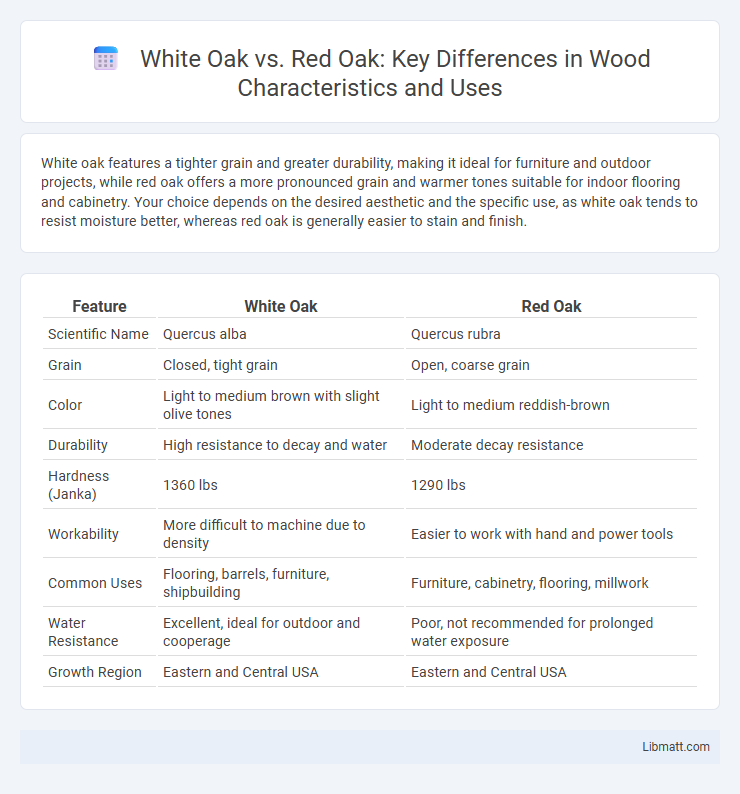White oak features a tighter grain and greater durability, making it ideal for furniture and outdoor projects, while red oak offers a more pronounced grain and warmer tones suitable for indoor flooring and cabinetry. Your choice depends on the desired aesthetic and the specific use, as white oak tends to resist moisture better, whereas red oak is generally easier to stain and finish.
Table of Comparison
| Feature | White Oak | Red Oak |
|---|---|---|
| Scientific Name | Quercus alba | Quercus rubra |
| Grain | Closed, tight grain | Open, coarse grain |
| Color | Light to medium brown with slight olive tones | Light to medium reddish-brown |
| Durability | High resistance to decay and water | Moderate decay resistance |
| Hardness (Janka) | 1360 lbs | 1290 lbs |
| Workability | More difficult to machine due to density | Easier to work with hand and power tools |
| Common Uses | Flooring, barrels, furniture, shipbuilding | Furniture, cabinetry, flooring, millwork |
| Water Resistance | Excellent, ideal for outdoor and cooperage | Poor, not recommended for prolonged water exposure |
| Growth Region | Eastern and Central USA | Eastern and Central USA |
Introduction to White Oak and Red Oak
White Oak and Red Oak are two popular hardwood species known for their durability and distinctive grain patterns, widely used in furniture and flooring. White Oak has a tighter grain and a more muted, creamy color, making it highly resistant to moisture and ideal for outdoor applications. Red Oak features a more pronounced grain with a reddish hue, offering a warm aesthetic that enhances the visual appeal of your interior spaces.
Botanical Differences Between White Oak and Red Oak
White oak (Quercus alba) features rounded leaf lobes with smooth, bristle-free edges, while red oak (Quercus rubra) has pointed lobes tipped with bristles, distinguishing their foliage. The wood grain of white oak is denser and more water-resistant due to tyloses in its vessels, contrasting with the more porous red oak. Understanding these botanical differences helps you select the appropriate oak type for specific applications like furniture or flooring.
Appearance: Grain Patterns and Color Variations
White oak features a tight, straight grain with subtle rays creating a slightly flecked appearance, and its color ranges from light beige to medium brown with a hint of gray. Red oak displays a more pronounced grain with wider, open pores and longer rays, showcasing a pinkish to reddish-brown hue. Your choice between these oaks depends on whether you prefer the more muted, uniform look of white oak or the bolder, warmer tones and textures of red oak.
Hardness and Durability Comparison
White oak exhibits a Janka hardness rating of approximately 1,360 lbs, making it harder and more resistant to dents than red oak, which rates around 1,290 lbs. Its dense grain structure contributes to superior durability, making white oak ideal for flooring and outdoor applications due to its natural resistance to moisture and decay. Red oak, while slightly softer, offers good durability for interior furniture and cabinetry but is more prone to wear and moisture damage over time compared to white oak.
Best Uses in Furniture and Flooring
White oak's dense grain and durability make it ideal for high-traffic flooring and heavy-use furniture like dining tables and cabinets, offering resistance to moisture and wear. Red oak, with its open grain and slightly softer texture, is preferred for decorative furniture and flooring where appearance and ease of finishing are prioritized over extreme durability. Both woods provide excellent structural integrity, but white oak's hardness and water resistance make it the superior choice for flooring subjected to heavy foot traffic and outdoor furniture applications.
Workability and Finishing Qualities
White oak features a coarse, tight grain that enhances its workability, making it easier to saw, plane, and sand compared to red oak. Its high density and closed cellular structure also allow white oak to accept stains and finishes more evenly, resulting in a smooth, durable surface. Red oak, while easier to work with hand tools due to its softer texture, tends to have a more porous grain that can cause blotchy finishes unless properly sealed.
Water and Decay Resistance
White oak demonstrates superior water and decay resistance due to its closed cellular structure, making it highly suitable for outdoor furniture and boatbuilding. In contrast, red oak's porous grain allows more water absorption, leading to higher susceptibility to rot and decay. This makes white oak the preferred choice for applications requiring enhanced durability in moist environments.
Cost and Availability
White oak generally commands a higher price than red oak due to its greater durability and resistance to moisture, making it a preferred choice for flooring and outdoor applications. Red oak is more widely available and typically less expensive, appealing to budget-conscious projects and indoor uses like furniture and cabinetry. Your selection between the two should consider these cost and availability factors alongside the specific needs of your project.
Environmental Impact and Sustainability
White oak is generally considered more sustainable due to its slower growth rate and longer lifespan, which supports forest ecosystems better than faster-growing red oak species. Red oak, while also renewable, often requires more frequent harvesting, potentially leading to higher environmental impact through soil erosion and habitat disruption. Your choice between these oaks can affect sustainability efforts, with white oak providing a more environmentally responsible option for long-lasting wood products.
Choosing the Right Oak for Your Project
White oak features a closed grain structure, making it highly durable and resistant to moisture, ideal for outdoor furniture and flooring. Red oak has an open grain with a reddish hue, offering a softer texture and easier stain absorption, suitable for indoor cabinetry and decorative pieces. Selecting between white oak and red oak depends on project requirements for strength, moisture resistance, and desired aesthetic.
White oak vs Red oak Infographic

 libmatt.com
libmatt.com